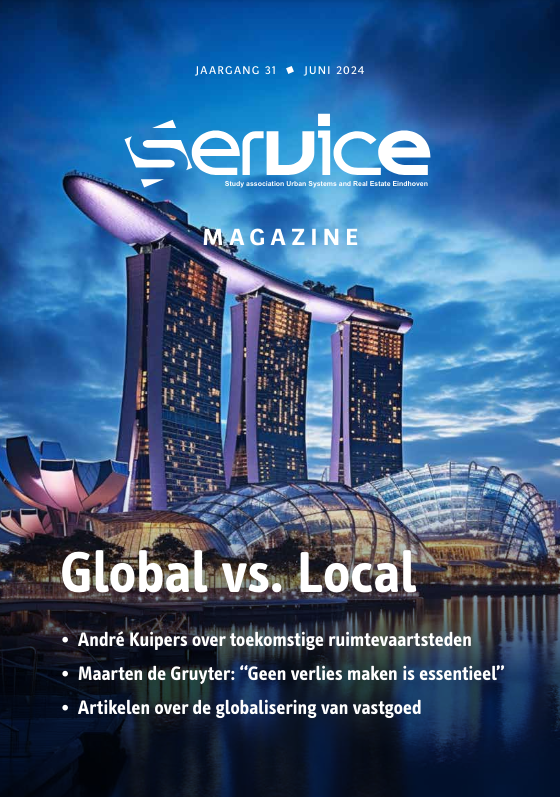Disease prevention in urban areas amid globalization and climate change
Editie: 31 - Global vs. Local
Published on: 07 juli 2024
It is estimated that more than 1.3 billion international arrivals were made in 2023, which is 88% of pre-COVID levels (UNWTO, 2024). Nevertheless, with the increase in international travel in the post-COVID era, travellers are becoming more susceptible to acquiring and spreading non-endemic diseases, resulting from increased risk of exposure to climate-sensitive health risks (Baker et al., 2022). As climate change becomes the biggest contributing factor for emerging infections, the urban environment in most parts of the developed world is also likely to change in response to travellers’ behaviour.
According to the United Nations’ sustainable development goal 11 (SDG 11), it states that “actions are to be taken to make cities and human settlements inclusive, safe, resilient and sustainable” (United Nations, 2023). This includes actions to reduce the number of people affected by disasters and direct economic losses caused by climate change, with the focus on the poor and most vulnerable people. Reports have noted that the rise in infectious health risks sustained in cities are a consequence of warmer climates, changing weather patterns, which increases the suitability of vectors, such as the Aedes mosquito, at higher latitudes (Matsee et al., 2023). Worldwide, the rate of dengue epidemics from mosquitoes have risen over the past 50 years, mainly in Latin America, Southeast Asia and Sub-Saharan Africa. In parts of Europe, especially areas around the mediterranean coastlines of France and Italy, dengue is becoming a public health threat (Buchs et al., 2022). Mosquito populations have already been established and are projected to migrate towards Northern Europe as the continent continues to experience warmer seasonal temperatures, increased precipitation, and higher humidity. Ten years ago, the European Centre for Disease Prevention and Control (ECDC) recorded cases in 114 regions over 8 EU/EEA countries. However, in December of 2023, mosquito populations have been established in 337 regions over 13 EU/EEA countries (ECDC, 2023a). Previously dengue-free countries such as France, Italy and Spain have all reported cases of autochthonous transmission – outbreaks that were not brought in from abroad (ECDC, 2023b).
The Incidence of viral outbreaks will be more common as disease carrying vectors become more resistant to pesticides, develop colder temperature tolerance and possibly viral mutation through cross-transmission of other diseases, particularly due to increased human activity, settlement, and international travel. The coronavirus epidemic has shown how rapid an uncontrolled disease can spread throughout the world, increasingly, the number of international travellers returning from dengue-prone areas have spurred the emergence of the epidemic in new places.
Disease management as part of a sustainable built environment strategy
One aspect of disease management which is often overlooked is to improve the built environment and the construction of new buildings with preventive measures to reduce establishment and infestations of infectious and invasive species (Lindsay et al., 2017). Such approach is extremely cost-effective and sustainable in the long term (Seidahmed et al., 2018). Biophysical properties, such as building design, materials, wind flow, and vegetation affect local temperature and humidity (Kache et al., 2022). The urban environment, characterized by their interconnectivity, provides excellent habitats conducive to the spread of disease-carrying vectors.
A study in Vietnam showed that climate change, urban infrastructure and human mobility are driving the emergence of dengue incidences in the country (Gibb et al., 2023). Urban growth was used to predict local spatial patterns of dengue, while mobility trends, human activity, and interactions with climate change was utilized as evidence for the expanding mosquito breeding population throughout Vietnam. Geographically, an immediate concern was found that the disease is expanding further into higher latitudes beyond its historical range. Transmission patterns are more locally dependent on the built environment characteristics, such as housing quality, density, drainage, or heat islands (Gibb et al., 2023), which provide amenable habitats for mosquito outbreaks.
As climate change becomes a serious concern in the decades to come, the focus of climate resiliency should not only be on renewable energy or nitrogen reduction, but also on emerging health risks such as dengue, which was not a problem in the past, but would be a climate threat in the future.
A (Singapore) city-state strategy for urban planning, public housing, and disease prevention
In Singapore, dengue is the most prominent of all arboviral diseases in residential and public establishments. The strategy employed by the Singapore government is one of population control, awareness campaign, and strategic urban planning to reduce the number of high risk and potential grounds for mosquitoes.
Over the past 50 years, Singapore has undertaken a progressive transformation of housing and urban planning. Urban residential housing in Singapore is classified into high-rise apartments, condominiums, and low-rise housing such as row terraces and semi-detached buildings. High-rise housing is mainly public housing owned by the Housing Development Board (HDB), the government agency which manages all public housing, while condominiums and low-rise housing are privately owned. Studies have been conducted that identified the relationship between dengue and urban housing as early as in the 1970s (Seidahmed et al., 2018), when the first strata of public housing in Singapore was established. Currently, new residential and commercial buildings are encouraged to have building features to reduce the number of potential breeding habitats. For instance, the presence of plants and roof gardens are common in newer apartment buildings which serves as an effective strategy at managing water stagnation (Fernandez et al., 2023).
Another key national strategy undertaken by the Singapore government is community participation in keeping living areas free from stagnating bodies of water and destroying breeding habitats for mosquitoes. Water management and pest control through elimination of potential sources of stagnant water are also taught in schools (National Environmental Agency, 2020). Public awareness campaigns, as well as heavy fines for public establishments that do not maintain a dengue-free environment can also deter potential disease outbreaks. This has resulted in extremely low incidences of dengue, despite Singapore being geographically situated in the most favourable climate and environment in the world for these creatures.
A recent study was also conducted to identify the relationship between urban features in high-rise public housing estates in Singapore, showed that except for plants in urban areas, all urban features studied were associated with higher risks of mosquito abundance (Fernandez et al., 2023). Older apartment buildings, through the accumulation of concrete cracks, debris, and infrastructure degradation were also associated with higher occurrences. Therefore, it is important to consider building deterioration and bioretention measures such as vegetation, when developing new housing projects, as newer buildings can also be at high risk of becoming potential sources for disease manifestations in the future.
Conclusions
In the post-COVID era, the focus on sustainability influences the way we live, work, and travel. Effective urban planning to reduce outbreaks and human contact is only successful if combined with citizen engagement. Improving the bio-environment health through sustainable urban planning strategies would not only reduce the spread of diseases but would also have other social and health benefits for the living environment. As climate change brings rising temperatures and irregular weather patterns, making improvements to the urban environment to minimize potential for large outbreaks of nuisance pests and disease carrying vectors should be a long-term goal for urban planners and developers in global cities. Moreover, recent changes to local transport infrastructure and human mobility patterns are having complex effects on transmission risks. Well-connected transport hubs are sources of local and international transmissions, with increasingly dense megacities being the most vulnerable to outbreaks.
Therefore, understanding the relationship between human mobility, the built environment, new building construction, and control of invasive species that pose a health threat is needed. The Dutch policy ambitions on achieving the SDGs by 2030 would only be met if proactive measures are taken today to safeguard and create resilient living conditions.
On the author: Melvin Wong
| Melvin Wong is an assistant professor in the Urban Planning and Transportation group in the department of Built Environment at Eindhoven University of Technology. His research focuses on Big Data analysis, data privacy in transportation systems, and discrete choice modelling. |  |
References
UNWTO (2024) UNWTO World Tourism Barometer and Statistical Annex, 22(1). ISSN 1728-9246.
Baker, R. E., Mahmud, A. S., Miller, I. F., Rajeev, M., Rasambainarivo, F., Rice, B. L., … & Metcalf, C. J. E. (2022). Infectious disease in an era of global change. Nature Reviews Microbiology, 20(4), 193-205.
United Nations (2023). The Sustainable Development Goals Report: Special Edition. Department of Economic and Social Affairs. https://unstats.un.org/sdgs/report/2023/.
Matsee, W., Charoensakulchai, S., & Khatib, A. N. (2023). Heat-related illnesses are an increasing threat for travellers to hot climate destinations. Journal of travel medicine, 30(4), taad072.
Buchs, A., Conde, A., Frank, A., Gottet, C., Hedrich, N., Lovey, T., Shindleman, H., & Schlagenhauf, P. (2022). The threat of dengue in Europe. New Microbes and New Infections, 49.
ECDC (2023a). Communicable Disease Threats Report: Weekly Bulletin (Week 50). European Centre for Disease Prevention and Control, Solna, Sweden. https://www.ecdc.europa.eu/sites/default/files/documents/communicable-disease-threats-report-week-50-2023.pdf.
ECDC (2023b). Increasing risk of mosquito-borne diseases in EU/EEA following spread of Aedes species. European Centre for Disease Prevention and Control. https://www.ecdc.europa.eu/en/news-events/increasing-risk-mosquito-borne-diseases-eueea-following-spread-aedes-species.
Lindsay, S. W., Wilson, A., Golding, N., Scott, T. W., & Takken, W. (2017). Improving the built environment in urban areas to control Aedes aegypti-borne diseases. Bulletin of the world health organization, 95(8), 607.
Kache, P. A., Santos-Vega, M., Stewart-Ibarra, A. M., Cook, E. M., Seto, K. C., & Diuk-Wasser, M. A. (2022). Bridging landscape ecology and urban science to respond to the rising threat of mosquito-borne diseases. Nature Ecology & Evolution, 6(11), 1601-1616.
Gibb, R., Colón-González, F. J., Lan, P. T., Huong, P. T., Nam, V. S., Duoc, V. T., et al. (2023). Interactions between climate change, urban infrastructure and mobility are driving dengue emergence in Vietnam. Nature communications, 14(1), 8179.
Seidahmed, O. M., Lu, D., Chong, C. S., Ng, L. C., & Eltahir, E. A. (2018). Patterns of urban housing shape dengue distribution in Singapore at neighborhood and country scales. GeoHealth, 2(1), 54-67.
Fernandez, S. A., Sun, H., Dickens, B. L., Ng, L. C., Cook, A. R., & Lim, J. T. (2023). Features of the urban environment associated with Aedes aegypti abundance in high-rise public apartments in Singapore: An environmental case-control study. PLOS Neglected Tropical Diseases, 17(2), e0011075.
National Environmental Agency (2020). NEA Partners Schools In Larger Dengue Cluster Areas To Distribute Mosquito Repellent And Educational Materials To Students. Press release, Aug 2020. https://www.nea.gov.sg/media/news/news/index/nea-partners-schools-in-larger-dengue-cluster-areas-to-distribute-mosquito-repellent-and-educational-materials-to-students.
Mail the editors